- Home
- Edgar Allan Poe
Classic Crime Collection
Classic Crime Collection Read online
CLASSIC CRIME COLLECTION
First published in Great Britain by Simon & Schuster UK Ltd, 2015
A CBS COMPANY
Supplementary materials copyright © 2007 by Simon & Schuster, Inc.
This book is copyright under the Berne Convention.
No reproduction without permission.
® and © 1997 Simon & Schuster, Inc. All rights reserved.
Simon & Schuster UK Ltd
1st Floor
222 Gray’s Inn Road
London WC1X 8HB
www.simonandschuster.co.uk
Simon & Schuster Australia, Sydney
Simon & Schuster India, New Delhi
A CIP catalogue record for this book is available from the British Library
Hardback ISBN: 978-1-47115-249-8
eBook ISBN: 978-1-47115-250-4
This book is a work of fiction. Names, characters, places and incidents are either a product of the author’s imagination or are used fictitiously. Any resemblance to actual people living or dead, events or locales is entirely coincidental.
Printed and bound by CPI Group (UK) Ltd, Croydon, CR0 4YY
Simon & Schuster UK Ltd are committed to sourcing paper that is made from wood grown in sustainable forests and supports the Forest Stewardship Council, the leading international forest certification organisation. Our books displaying the FSC logo are printed on FSC certified paper.
CONTENTS
INTRODUCTION
CHRONOLOGY OF EDGAR ALLAN POE’S LIFE AND WORK
HISTORICAL CONTEXT OF THE WRITINGS OF EDGAR ALLAN POE
TALES
THE TELL-TALE HEART
THE CASK OF AMONTILLADO
THE BLACK CAT
LIGEIA
THE MASQUE OF THE RED DEATH
THE FALL OF THE HOUSE OF USHER
THE MURDERS IN THE RUE MORGUE
THE PURLOINED LETTER
THE GOLD-BUG
MS. FOUND IN A BOTTLE
A DESCENT INTO THE MAELSTRÖM
THE PIT AND THE PENDULUM
WILLIAM WILSON
POEMS
THE RAVEN
LENORE
TO HELEN
ULALUME
THE BELLS
ANNABEL LEE
TO ————
THE VALLEY OF UNREST
THE CITY IN THE SEA
THE SLEEPER
A DREAM WITHIN A DREAM
DREAM-LAND
DREAMS
SILENCE
ELDORADO
ISRAFEL
FOR ANNIE
SONNET—TO SCIENCE
A DREAM
TO ————
ROMANCE
SPIRITS OF THE DEAD
TO HELEN
EVENING STAR
ALONE
NOTES
INTERPRETIVE NOTES
CRITICAL EXCERPTS
QUESTIONS FOR DISCUSSION
INTRODUCTION
Great Tales and Poems of Edgar Allan Poe:
DREAMS WITHIN A DREAM
Edgar Allan Poe died penniless and largely unappreciated, and in America he was mostly ignored for the latter half of the nineteenth century. But popular culture has been good to Poe; his stories and poems have been adapted into movies, inspired whole genres of novels, and been quoted and parodied in countless television shows and paperback thrillers. Once he was considered an eccentric minor figure, a genius who was constitutionally unable to achieve real success. But modern readers of detective stories, gothic and horror novels, and science fiction consider Poe a pioneer. The annual awards for excellence given by the Mystery Writers of America, the Edgars, are named after Poe in recognition of his central importance in creating the first ratiocinative (i.e., methodical and logical) detective, C. Auguste Dupin.
Poe’s prose work in particular was written to capture the attention of a mass audience, at a time when there was great competition from other magazine journalists. His lurid imagination certainly made him stand out. Never one to moralize, unlike most of the writers of the day, Poe was interested solely in the aesthetic experience. He wrote about two sides of the life of the mind: the mind deranged by guilt, desire, or loss; and the rational mind that can impose order on a seemingly incomprehensible world. Although today Poe is treasured mostly by lovers of his gothic sensibility, he also had a sly sense of humor and a penchant for put-ons that remind us not to take even his most morbid writing completely seriously.
The Life and Work of Edgar Allan Poe
Edgar Allan Poe was born in Boston on January 19, 1809, into a family of actors. His father, David Poe, disappeared from his life before Poe was old enough to remember him, and his mother, Elizabeth, died shortly before Edgar’s third birthday. Edgar; his older brother, Henry; and his sister, Rosalie, were taken in by different families. Edgar was raised in Richmond, Virginia, in the home of John Allan, a local merchant, and his wife, who had no children of their own. When Allan moved his family to England in 1815 in order to expand his mercantile business, Edgar attended several boarding schools during the five-year stay. Allan’s British business endeavor ultimately failed, and the family returned to Richmond in 1820.
Despite the family’s financial straits, Poe received the best education available in Richmond. He was a prizewinning scholar and an athlete, successful in school if not exactly popular. He attended school with the sons of some of the most prestigious families in Virginia, but his status as an orphan and the ward of John Allan, who never formally adopted Edgar, separated him from his peers, at least in his own mind. In 1826, at age seventeen, Poe entered the University of Virginia to study ancient and modern languages. When he racked up several thousand dollars in gambling and other debts during that first year at school—the result of his determination to present himself as a young man of means—his relationship with his foster father, already strained, reached the breaking point. Allan refused to send Poe back to the university in the spring, and Poe left the house, writing to Allan, “My determination is at length taken . . . to find some place in this wide world, where I will be treated—not as you have treated me.” After complaining of what he considered to be his second-class status in the Allan household, Poe closed the letter with a request for money to get him started in Boston. In April 1827, he headed north on his own. It is unknown to historians whether or not he had assistance in this venture from Allan.
By the end of May that same year, Poe had enlisted in the army under an assumed name. He had also published his first book of poetry, Tamerlane and Other Poems, which he signed “By a Bostonian.” In the army he trained as part of an artillery battery; over a period of eighteen months he was stationed in Boston Harbor, at Fort Moultrie on Sullivan’s Island in South Carolina (the setting for his story “The Gold-Bug”), and at Fortress Monroe in Virginia. Poe rose to the rank of sergeant major but was dissatisfied with army life. In letters he sought the help of John Allan in arranging a discharge rather than serving his full five-year term of enlistment, in order to enter West Point. While waiting to enter the academy, he published a second collection of poems, Al Aaraaf, Tamerlane, and Minor Poems, in December 1829.
Also in 1829, Poe went to Baltimore to visit the branch of his family that his brother, Henry, had been living with: his grandmother, his aunt Maria Clemm, and her children, Henry and Virginia. His career at West Point turned out to be short-lived; another financial dispute with his foster father led to a renewed, more or less complete estrangement between the two, and Poe resolved to get himself court-martialed by disobeying regulations. He was formally discharged from military service in March 1831. While awaiting dismissal he prepared another volume of verse, Poems by Edgar A. Poe. Second Edition, for publication, drumming up subs
criptions among his fellow cadets to pay for the book.
Poe returned to Baltimore to live with his grandmother and the Clemms in the spring of 1831. Over the next several years, while barely scraping together a living from a series of odd jobs, he published his first stories in the Philadelphia Saturday Courier and the Baltimore Saturday Visiter. Poe’s story “Ms. Found in a Bottle” won a first prize of fifty dollars in a literary contest sponsored by the Visiter in October 1833. In March of the following year, John Allan, who had mostly rebuffed Poe’s occasional attempts to contact him in the years since he had left West Point, died; he did not provide for Poe in his will. Winning the Visiter prize, though, led Poe to a promising association with a Richmond magazine, the Southern Literary Messenger, which published his stories and reviews and, in August 1835, took him on as a staff editor.
Meanwhile, with the death of Poe’s grandmother in July 1835, the Clemms lost their sole means of support. When Maria Clemm wrote to her nephew that she and Virginia were to be taken into the home of another relative, Poe became distraught. His life with the Clemms had been the closest thing to a loving family life he had known. Promising that he could support them with his position at the Messenger, he proposed to marry Virginia and to bring her and her mother to Richmond. Virginia was thirteen at the time. They likely married in secret in Baltimore in September 1835, and in May 1836 took out a second marriage license in Richmond, on which it was claimed that Virginia was “of the full age of twenty-one years.” Poe wrote prolifically for the Messenger during this time, including hundreds of reviews that frequently offended the literary establishment of the day with their cutting judgments. By the end of 1836, after disputes with Messenger owner T. W. White, Poe was again out of work.
Poe relocated to New York City in February 1837, seeking new prospects in the publishing capital of the still-young United States. Since New York was also at the center of a financial depression that afflicted the country beginning a few months later, it was a particularly unpromising time and place to attempt to support a household. Poe, his wife, and mother-in-law lived on bread and molasses for weeks at a time. Little is known about what he did in New York over the following year. He published two stories and wrote his longest work, the short novel The Narrative of Arthur Gordon Pym. Around the time Pym was published, in July 1838, Poe moved his family again, this time to Philadelphia, where they lived for the next five years.
In the spring of 1839, Poe entered into a partnership with actor and playwright William Burton to serve as coeditor of a new periodical, Burton’s Gentleman’s Magazine. Poe wrote most of the reviews that appeared in the magazine over the next year and published some of his best-known stories: “Ligeia,” “The Fall of the House of Usher,” and “William Wilson.” These stories appeared along with twenty-two others in Poe’s first collection of short fiction, the two-volume Tales of the Grotesque and Arabesque, which was published in 1840. He also attempted to start his own magazine, even soliciting subscriptions, but was unable to raise enough money. In late 1840 Burton’s was sold and became Graham’s Magazine, and Poe stayed on as editor.
Poe’s editorial positions were inevitably short-lived. He struggled with alcoholism and gained a reputation for unreliability, although he contributed prodigiously to the periodicals for which he wrote. In Graham’s he published “A Descent into the Maelström” and “The Murders in the Rue Morgue,” among other stories and many reviews. He had his greatest success when he published “The Raven” in the New York Evening Mirror in January 1845, which made him one of the most famous poets of his time. Yet he was preoccupied with his inability to care for Virginia, who was suffering from tuberculosis. The New York newspaper editors, who sometimes waged contentious wars of words with Poe, published appeals for donations on his family’s behalf. After Virginia’s death in January 1847, Poe’s health collapsed. He was unable to appear in court for the libel suit he brought against the owners of the New York Mirror, who had published allegations of fraud and embezzlement against him; though he won the suit, he received about two hundred dollars in damages, considerably less than the five thousand dollars he claimed.
Poe had recovered somewhat by the end of 1847, when he published the poem “Ulalume” in the American Review. In February 1848, a few days after the first anniversary of Virginia’s death, he gave a public lecture on “The Universe,” which became the basis for his philosophical treatise Eureka, published in July. A pseudoscientific speculative essay about the “Heart Divine” that remakes the universe with each throb, Eureka was generally derided by critics (whom Poe thought misunderstood it) and failed to make much of an impact. Poe wooed a series of women during this time, sometimes dedicating verse to them, but the courtships tended to end badly. He attempted suicide when his affair with Sarah Helen Whitman failed; she broke off their engagement in January 1849 when he started drinking again.
Poe made another attempt to revive his literary career, publishing new stories and giving lectures. His health was deteriorating, however, and friends reported that he was suffering from occasional bouts of hallucinations. He returned to Richmond for the first time in more than ten years, seeking money for another magazine project, the Stylus. While there, he renewed his acquaintance with Elmira Royster Shelton, his childhood sweetheart whose family had kept them apart years before. She was now a widow, and she had never completely gotten over her youthful affection for Poe. When he left Richmond for business on September 27, 1849, Poe believed that he and Elmira had become engaged.
But Poe never returned to Richmond. A week later, on October 3, he turned up in Baltimore, under circumstances that will likely always be a mystery. He was apparently drunk and delirious, and wearing ill-fitting, shabby clothes that did not seem to be his. He lingered in a hospital for four days before succumbing to a fever, possibly encephalitis. He was never coherent enough to explain what had happened during the week he had vanished. He was buried in Baltimore, attended by a small group of mourners.
Historical and Literary Context of Poe’s Writings
The Young Republic
Poe lived from 1809 until 1849, a turbulent early period in American history after the nation gained its independence and before regional and political tensions exploded into civil war. He was a proponent of “art for art’s sake,” and so he rarely engaged, at least directly, with the controversial issues of the day in his poems, stories, or criticism. But no American of the time could be unaffected by the rapid changes in the country, namely the westward expansion and the explosion of population of the cities of the Northeast. Poe was one of the many who came to these metropolitan centers—New York, Philadelphia, Boston, Baltimore—seeking fortune. He made a name for himself in his brief literary career, but as an adult he was plagued by the poverty that was common in the United States of the early nineteenth century. His circumstances are an example of how precarious life in the city could be at the time: Poverty contributed to his ill health and death at forty and to the early deaths of his mother, brother, and wife.
Some critics have argued that Poe’s morbid fantasies, though frequently set in faraway places and a mythical timeless past, are psychological projections of the anxieties of the young United States: the pains of starvation and illness; the violence of urban crime and the threat of war; the grief of orphanhood and the loss of loved ones. If Walt Whitman was the nineteenth century’s optimistic voice of the American dream, Poe was his nightmare counterpart. (Incidentally, Whitman was the only poet to attend the service when a memorial to Poe was dedicated in Baltimore in 1875.) At the same time, in his puzzle stories such as “The Murders in the Rue Morgue” and “The Gold-Bug” and in his literary criticism, he asserted the power of the rational mind to impose some sort of order on the chaos of life.
Romanticism
As a poet, Poe’s role models were the English poets of the late eighteenth and early nineteenth century known as the Romantics. He was especially influenced by Samuel Taylor Coleridge, whose best-known poem, “The Rim
e of the Ancient Mariner,” is a desolate maritime fantasy that Poe no doubt had in mind when he created the ghost ship of “Ms. Found in a Bottle.” Coleridge was also known for his writings about poetry, which Poe drew from for his own theories of the poetic imagination in lectures and essays. In “Letter to Mr.— ——,” written to the publisher Elam Bliss and published as the preface to Poe’s 1831 collection Poems, he wrote: “In reading his poetry I tremble, like one who stands upon a volcano. . . .” Poe shared with Coleridge the ideas that poetry comes to the poet in dreams and visions, that poets should strive to attain beauty rather than truth, and that the most poetically beautiful subjects are sad ones.
Poe was born in the same year as Alfred Lord Tennyson, an English Romantic poet he admired. Tennyson lived until nearly the end of the nineteenth century, long enough to become the English poet of the Victorian era; Poe, on the other hand, died the year before the first great flowering of American Romanticism, known as the American Renaissance, began. And he was not acknowledged as much of an influence by great contributors to the American Renaissance such as Herman Melville, Nathaniel Hawthorne, Ralph Waldo Emerson (who once referred to Poe as “the jingle man”), and Whitman. Europeans were much more enthusiastic about Poe. Tennyson returned the compliments of his American admirer, calling him “the most original genius that America has produced.” Charles Baudelaire, who translated Poe into French in Paris, was his great champion; in his magazine, Fyodor Dostoyevsky published Russian translations of the “strange, though enormously talented” Poe. Overseas he was widely appreciated for his fevered, dreamlike tales and poems—a morbid dark side to the Romantic celebration of the individual imagination.
Early American Literary Journalism
Poe was a widely recognized participant in the media wars of his day, the free-for-all competition among hundreds of American newspapers and magazines in the 1830s and 1840s. There were dozens of newspapers in New York City alone in the 1830s, all clamoring for the attention of a growing urban reading public. Especially given the lax copyright laws of the day, publishing books was not a viable way for writers of the time to make a living. Many of them supported themselves, and found a regular outlet for their writing, by editing newspapers or journals. Walt Whitman was an editor of several New York newspapers of the time, as were Margaret Fuller, John Greenleaf Whittier, and William Cullen Bryant. Among his fellow literary journalists, Poe earned a reputation as a biting critic. He was known, and in some circles held in contempt, for his attacks on fellow writers such as Theodore S. Fay (who Poe said wrote like a schoolboy) and Henry Wadsworth Longfellow. Poe took it upon himself to offer a comprehensive appraisal of the literary landscape of the time called “The Literati of New York City,” which appeared in six parts in Godey’s Lady’s Book in May through October 1846. Not surprisingly, he was also on the receiving end of satire from rivals. James Russell Lowell, for example, in his “The Fable for the Critics,” wrote: “Here comes Poe with his Raven, like Barnaby Rudge— / Three-fifths of him genius, and two-fifths sheer fudge; / Who talks like a book of iambs and pentameters, / In a way to make all men of common sense d—n metres. . . .”

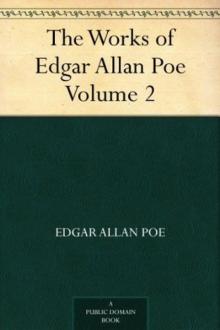 The Works of Edgar Allan Poe — Volume 2
The Works of Edgar Allan Poe — Volume 2 The Works of Edgar Allan Poe — Volume 1
The Works of Edgar Allan Poe — Volume 1 The Works of Edgar Allan Poe — Volume 3
The Works of Edgar Allan Poe — Volume 3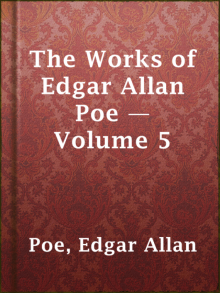 The Works of Edgar Allan Poe — Volume 5
The Works of Edgar Allan Poe — Volume 5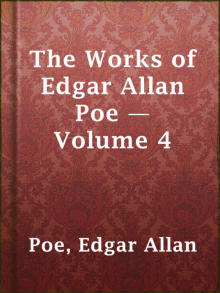 The Works of Edgar Allan Poe — Volume 4
The Works of Edgar Allan Poe — Volume 4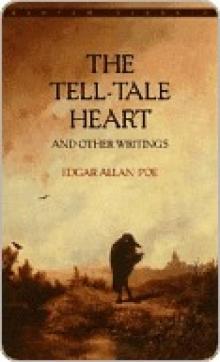 The Tell-Tale Heart
The Tell-Tale Heart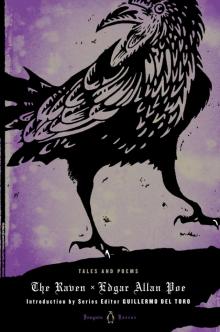 The Raven (Penguin)
The Raven (Penguin)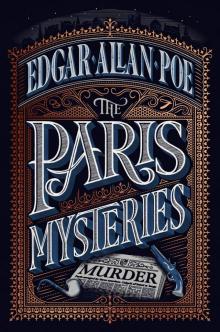 The Paris Mysteries
The Paris Mysteries Tales of Terror from Edgar Allan Poe
Tales of Terror from Edgar Allan Poe The Fall of the House of Usher
The Fall of the House of Usher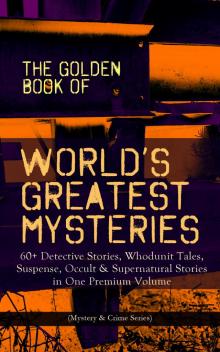 The Golden Book of World's Greatest Mysteries
The Golden Book of World's Greatest Mysteries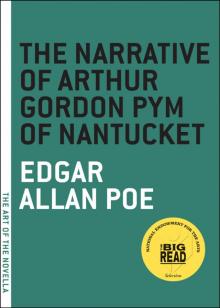 The Narrative of Arthur Gordon Pym of Nantucket
The Narrative of Arthur Gordon Pym of Nantucket Ligeia
Ligeia The Landscape Garden
The Landscape Garden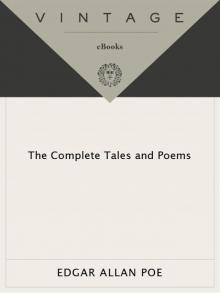 Complete Tales & Poems
Complete Tales & Poems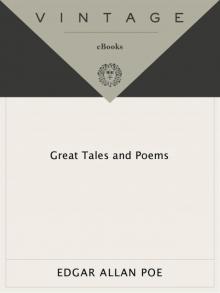 Great Tales and Poems of Edgar Allan Poe
Great Tales and Poems of Edgar Allan Poe The Colloquy of Monos and Una
The Colloquy of Monos and Una The Oblong Box
The Oblong Box Thou Art the Man
Thou Art the Man A DESCENT INTO THE MAELSTROM
A DESCENT INTO THE MAELSTROM THE MURDERS IN THE RUE MORGUE
THE MURDERS IN THE RUE MORGUE The Business Man
The Business Man The Mystery of Marie Rogêt
The Mystery of Marie Rogêt Metzengerstein
Metzengerstein The Man That Was Used Up
The Man That Was Used Up William Wilson
William Wilson The Philosophy of Composition
The Philosophy of Composition The Portable Edgar Allan Poe
The Portable Edgar Allan Poe Bon-Bon
Bon-Bon A Predicament
A Predicament The Premature Burial
The Premature Burial The Angel of the Odd
The Angel of the Odd The Man of the Crowd
The Man of the Crowd Never Bet the Devil Your Head
Never Bet the Devil Your Head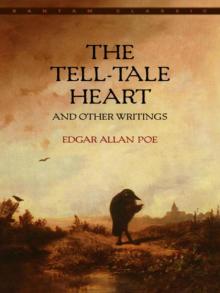 The Tell-Tale Heart and Other Writings
The Tell-Tale Heart and Other Writings The System of Doctor Tarr and Professor Fether
The System of Doctor Tarr and Professor Fether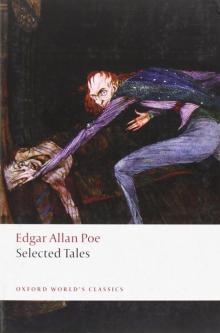 Selected Tales (Oxford World's Classics)
Selected Tales (Oxford World's Classics)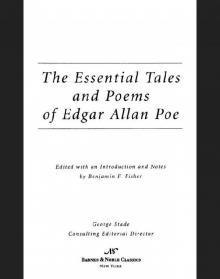 Essential Tales and Poems of Edgar Allan Poe (Barnes & Noble Classics Series)
Essential Tales and Poems of Edgar Allan Poe (Barnes & Noble Classics Series) MS. Found in a Bottle
MS. Found in a Bottle Some Words with a Mummy
Some Words with a Mummy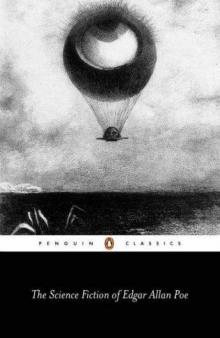 The Science Fiction of Edgar Allan Poe (Penguin Classics)
The Science Fiction of Edgar Allan Poe (Penguin Classics) King Pest
King Pest CRITICISM
CRITICISM How to Write a Blackwood Article
How to Write a Blackwood Article Mystification
Mystification Diddling Considered as One of the Exact Sciences
Diddling Considered as One of the Exact Sciences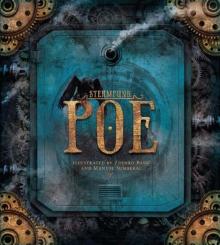 Steampunk Poe
Steampunk Poe The Literary Life of Thingum Bob, Esq.
The Literary Life of Thingum Bob, Esq.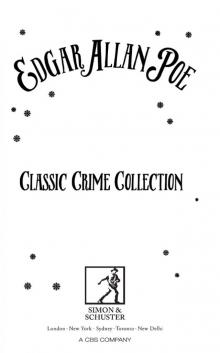 Classic Crime Collection
Classic Crime Collection Complete Stories and Poems of Edgar Allen Poe
Complete Stories and Poems of Edgar Allen Poe Berenice
Berenice The Black Cat
The Black Cat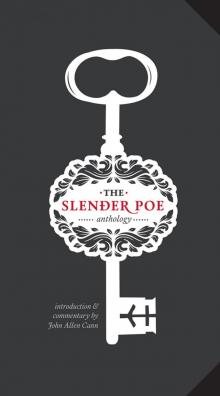 The Slender Poe Anthology
The Slender Poe Anthology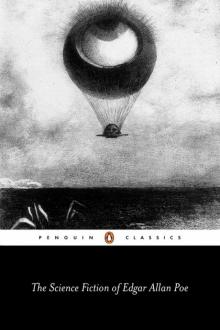 The Science Fiction of Edgar Allan Poe
The Science Fiction of Edgar Allan Poe The Assignation
The Assignation The Thousand-and-Second Tale of Scheherazade
The Thousand-and-Second Tale of Scheherazade The Raven and Other Short Stories
The Raven and Other Short Stories The Spectacles
The Spectacles Hop-Frog
Hop-Frog The Purloined Letter
The Purloined Letter Mellonta Tauta
Mellonta Tauta The Balloon-Hoax
The Balloon-Hoax Landor's Cottage
Landor's Cottage Mesmeric Revelation
Mesmeric Revelation The Pit and the Pendulum
The Pit and the Pendulum